#y2k hand sanitizer
Explore tagged Tumblr posts
Text
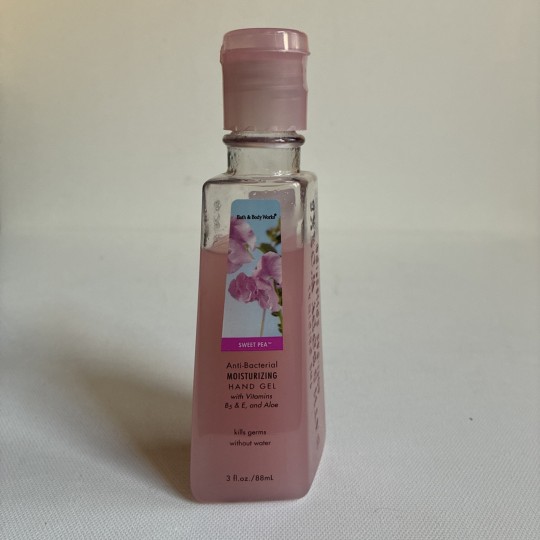
Bath and Body Works Sweet Pea Anti Bacterial Moisturizing Hand Gel
early 2000s (expired 2006)
Found on Ebay, seller goldenhourvintage01
#bath and body works sweet pea#sweet pea#vintage bath and body works#vintage bath and body works hand gel#early 2000s bath and body works#early 2000s anti bacterial#early 2000s sweet pea#y2k sweet pea#y2k bath and body works#early 2000s hand gel#y2k hand gel#y2k anti bacterial#pink#early 2000s nostalgia#early 2000s fragrance#early 2000s kids#early 2000s childhood#early 2000s#y2k nostalgia#y2k kids#y2k childhood#y2k fragrance#y2k#anti bacterial#early 2000s hand sanitizer#y2k hand sanitizer#hand sanitizer
6 notes
·
View notes
Text
𝕴𝖓 𝖆 𝖑𝖆𝖓𝖉 𝖔𝖋 𝖒𝖞𝖙𝖍 𝖆𝖓𝖉 𝕸𝖆𝖌𝖎𝖈...
Or a necessary list of things i scripted for my camelot dr.

Click here to see my dr introduction.
꩜ .ᐟ No patriarchy. I ain't dealing with that shit in medieval times aswell, im sorry. We live in a gylany (won't cease to recommend marija gymbutas research if you want to dig deeper in that).
꩜ .ᐟ The triple goddess is worshipped: maiden, warrior, mother. And she is usually represented with Excalibur, the sacred sword in the stone which is a symbol of unity between the masculine (the sword) and the feminine (the stone as the womb of the earth). That doesn't mean its an hetero-based world tho, but methaphorically speaking It serves as a symbol of equality, and thats why it is worshipped or respected.
꩜ .ᐟ the clothing style is medieval-like. on one hand we have the og clothes— gowns, breeches, doublets, overgowns with long sleeves, etc. but at the same time theres not that much of a taboo or purity culture about the body —specially the female body— so the length of the clothes are not always that long. Think of the movie "Ella enchanted" and their medieval y2k aesthetic and you kinda get an idea of what i mean. Body parts can be visible such as shoulders, bellies, knees... and i also scripted sort of 'medieval swimsuits' because this girl has the soul of naiad and i cannot resist to have a good swim on a pretty turquoise waterfall during summer and hot weather.
꩜ .ᐟ bardcore-style modern songs. I saw the bardcore covers from youtube and i had a vision —I Need a Hero as the sacred drinking anthem at the tavern.
꩜ .ᐟ household appliances such as fridges, microwaves, showers, toilets, bidets... but instead of electricity, they work with ✨magic✨. as much as i love the middle ages, i rather not get food poisoned, or infected by bacteria or simply being hit by the incredible aroma of human waste every time i leave the castle........ so yea there are also heating, sanitation, plumbing systems , etc. and hygiene and medical knowledge are very common and well developed. Also accesible to everyone no matter their social status.
꩜ .ᐟ People work not out of obligation but contribution. Nobody starves or is exploited. I might be a member of the court but i also have empathy for the human condition. (I could also talk about how in the Ancient Regime people used to have more free time than we do now under capitalism, but thats just an historical rant for another time).
꩜ .ᐟ the grey cloaks. A group of physicians and doctors for emergencies. They run and drive horse-drawn ambulances that can be enchanted by magic if needed to reach the nearest hospital during a rush.
꩜ .ᐟ talking about emergencies there are also fire brigades. A group of strong and agile men and women with fire-resistant leather tunics who train hard for rescue operations.
꩜ .ᐟ Of course we also have the knights of camelot when it comes to protection, but they are more related to the crown and have various degrees. Some of them work as mere knights, kind of like a police patrol; but some others have a more important range since are members of the round table, hence they can be the heads of patrol and other political or diplomatical operations aswell.
꩜ .ᐟ Conflicts are resolved through councils of the wise led by the monarch, not through battles. It is an evolved society where dialogue is sacred. The army exists, but only for ceremonials, and knights serve more as a symbol of honor than for any real need for serious combat. They are the symbol of the kingdom's protection.
꩜ .ᐟ Horse races, swordfighting and archery competitions are like football for the argentinians: sacred, loved passionately and truly a cultural obssesion. There are betting booths, food charts and 'merchandising'. Held every summer theres a Grand Tournament (world cup vibes) where even the camelot' knights participate if they want to because they are supposed to be safe (i don't want my friends to die, thanks), just like a fighting or martial art tournament.
꩜ .ᐟ FaceTime poket mirrors. Look I don't want phones to exist but i would like a way to communicate with people fastly. There are also messager pigeons that carry big or tiny scrolls to send mail faster than usual.
꩜ .ᐟ sunglasses (and normal glasses because its truly an invisible disability) and old polaroids. I don't care. I just want to have pictures registered in a physical album, some sort of codex memoriae or something. Plus i love to see baby photos of the people in my life.
꩜ .ᐟ movies are all adapted into a medieval framework. Scenery, clothes, aesthetics, artistry, culture... Whatever but make it medieval. Plays are very common and popular aswell because of their incredible effects and sceneries. Suddently A Knights Tale isn't a funny anachronistic experiment but a biblically accurate despiction of the period; the princess bride keeps being an old time classic; and 10 things i hate about you becomes X Things I Curse Thee Form, a romcom tale where a shrewish noblewoman must be wooed before her sister can wed, so a dashing mercenary knight takes the challenge. I think you get the idea.
꩜ .ᐟ there are fast-travel hacks. We have the horseback riding, carts and carriages or river barges, but we also have fey paths for desperately fast ways to travel to places that are further away. They consist of stone circles near the pathway or rocks in the trails marked with spirals. That way, a three-day journey by horse can be done in a few hours.
꩜ .ᐟ food of all kinds, incredibly tasty. The royal cuisine custodies the recipe book like a church its relicary, and then smaller copies and volumes are distributed in town. Don't expect historical accuracy, theres sugar, coccoa and coffee, pesto and probably sushi. Takeway food in the taverns and inns and ofc all the possible types of cheescake that you can think of. Let me live in peace.
𖦹⋆.ೃ࿔*:・



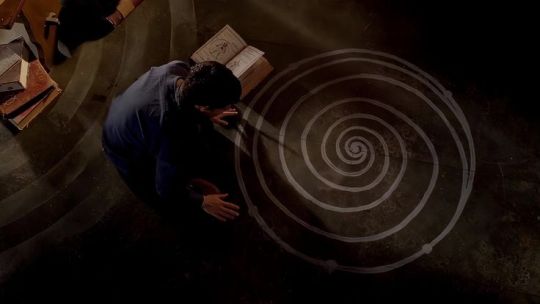

#desired reality#law of assumption#reality shifting#ladyrohan's camelot dr#camelot dr#shifting reality#shifting#manifesting#reality shift#reality shifter#shifting community#shiftinconsciousness#shifting blog#shifting diary#shiftblr#shifters#shifter#shifting script#shifting to desired reality#shifting realities#shifting stories#shifting antis dni#shifting motivation
97 notes
·
View notes
Text
I need your guys opinion! If you were to receive a goodie bag from a party, what would you want in it?
I’m trying to get ideas for my birthday party in July but I wanna think about what to add into little goodie bags. My theme is Y2K so anything within that theme would be highly recommended!
I already have candy and stickers as one of the ideas already. I’ve done hand sanitizers before but I wanna explore more options!
7 notes
·
View notes
Text
Visit Julia Beauty’s New Outlet in Chinatown: Walk-in or Book Now
Looking for a trusted nail salon in Chinatown that doesn’t mess around with quality? Well, your search just got easier because Julia Beauty has opened its latest outlet right in the heart of Chinatown, Singapore. Whether you're walking in from your lunch break or planning a weekend pamper session, this new spot is made to give you that polished look without the drama.
Let’s break down what makes this place worth the hype and why your next mani-pedi shouldn’t happen anywhere else.
A Quick Glance: Where Exactly?
Julia Beauty – Chinatown Branch 3 Pickering Street, South Bridge Rd, #01-47 Nankin Row, Singapore 048660
You can’t miss it. Right in the vibrant lanes of Chinatown, surrounded by cafes, bubble tea joints, and culture-rich corners, this location makes it easy to turn a beauty session into a full chill day.
Not Just Another Nail Salon in Chinatown
Let’s be real Chinatown has plenty of nail spots. Some okay, some... let’s say “risky.” But Julia Beauty isn’t some pop-up shop with a laminated price list and mystery reviews.
This is a full-service beauty outlet built on:
Consistency in service
Premium products
Experienced nail artists who actually listen
A calm, modern space that doesn’t feel like a beauty factory
Whether you want gel extensions, clean natural nails, or a trending chrome finish they’ve got it down to a science. And yeah, they’re good with nail art too. No shaky lines here.
Why Julia Beauty Is Gaining Buzz
1. They Get Your Aesthetic
You show them a Pinterest screenshot, they won’t panic. Their techs actually stay updated with trends from Korean-inspired minimalist nails to bold Y2K pop colors. Whether it’s almond shape with a nude ombré or Hailey Bieber’s glazed look, they deliver.
2. Quick But Never Rushed
Walk-ins are welcome, but the team never treats you like a number. You won’t be left soaking your hand for 30 minutes while the staff rotates between clients. Bookings are smooth, timing’s tight, and walk-ins are handled respectfully.
3. Hygiene? 10/10
Every file, brush, and basin goes through strict hygiene protocols. Tools are sanitized, buffers are one-use, and everything smells clean no weird salon odors. You’d be surprised how rare that is in the area.
4. Wallet-Friendly Without Looking Cheap
Prices are mid-range, but the finish feels luxury. You’re not paying $10 for a 10-minute job, but you’re also not being upsold into a $180 nail set unless you want it. Expect transparency and zero pressure.
Services You’ll Want to Try
Here’s what’s popular at the new outlet right now:
Express Gel Mani/Pedi – For when you're on the clock
Classic Gel Mani with Nail Art – Custom styles, minimal to bold
Hard Gel Extensions – For durable glam without looking chunky
Natural Nail Care – Buffing, shaping, cuticle health
Nail Repair & Overlay – For weak or brittle nails that need support
They also offer nail care add-ons like paraffin wax, collagen treatments, and protein coats especially useful if your nails have been through acrylic trauma or back-to-back gel sessions.
What Customers Are Saying
Real reviews from clients who’ve already visited the Chinatown outlet:
“I walked in with weak, chipped nails — walked out with clean gel overlays that look like I was born with them. The staff didn’t push anything unnecessary. Love that.” – Priya L. “Very chill vibe, clean setup. Got my extensions fixed in under 45 minutes. Definitely coming back!” – Zoe T. “Hands down my new go-to for nail art. They actually understood what I wanted and the result was even better than my inspo photo.” – Jessie W.
Instagram-Worthy Results (Without Filters)
Nails aren’t just a grooming thing anymore they’re full-on self-expression. The Chinatown branch keeps up with that. You’ll see clients walking out with:
Matte nudes with minimalist dots
Barbiecore pink with sparkle topcoat
Abstract art vibes that look like wearable gallery pieces
Classic French with updated twists (metallic tips, double lines)
Their Instagram page also features real client sets no AI-generated or overly filtered nonsense.
The Techs Know Their Craft
Unlike random salons where you’re unsure who’s working on you, Julia Beauty’s team is well-trained and consistent. They:
Ask about your preferences before they start
Adjust shaping based on your nail bed
Know how to handle sensitive cuticles
Don’t over-file or damage the nail base
And yes, they speak both English and Mandarin — smooth communication, no awkward guessing games.
Real Talk: What to Expect in Terms of Price
Here’s a quick average range (as of June 2025):
Gel Manicure: $40–$65
Extensions: $80–$110
Nail Art Add-ons: $5–$30 depending on complexity
Nail Repair: $10–$25 per nail
Express Classic: $25–$35
For the level of quality, hygiene, and comfort it’s more than fair. No hidden charges or weird upcharges when you're halfway done.
Final Word: Is It Worth Going?
If you’re around Chinatown and want a nail salon that’s clean, stylish, and consistent, Julia Beauty’s new outlet is a no-brainer. Whether it’s your regular self-care day or a pre-event glam session, they’ll get you in and out without stress.
Walk-in if you’re nearby or book ahead to skip the wait and get the tech of your choice.
How to Book or Find Them
Location: 3 Pickering Street, #01-47 Nankin Row, Singapore 048660
Call or WhatsApp: 6582215895
Booking Link: Nail Salon in Chinatown
📷 Follow them on IG: @juliabeauty.sg
Got your next set in mind? Time to stop scrolling inspo and actually book it. Julia Beauty in Chinatown is open and ready your nails deserve the upgrade.
0 notes
Text
408. Purell
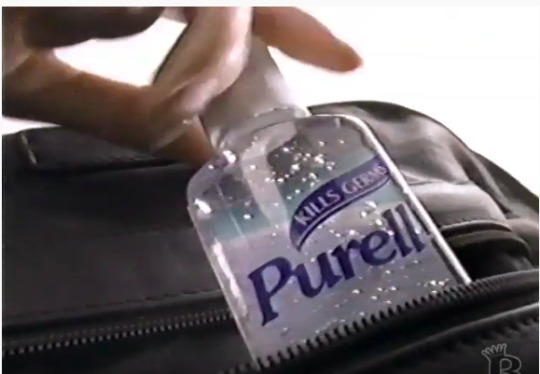
I remember where I was the first time I saw a commercial for Purell. It was an early morning sometime in 1997, as I was getting ready for school. Mom had Good Morning America on in the living room, and I saw on TV (what I remembered at the time as) a trembling hand getting ready to touch an ATM keypad. The voiceover was something along the lines of, “think of all the other people who touched those buttons”.
I found the commercial, and I rewatched it for the first time in 22 years.
Ok, the voiceover guy said, “Germs live on all types of things. Even the things we touch every day.” Also, the guy’s hand wasn’t trembling.
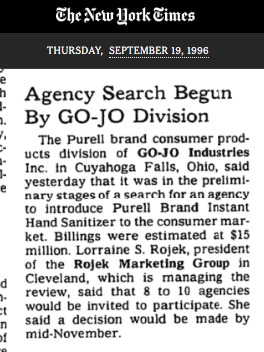
The agency search for that commercial began in the fall of 1996.
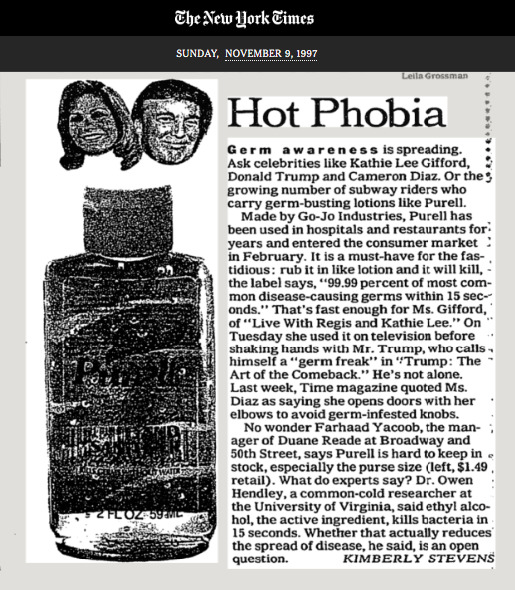
Kathie Lee Gifford approved of it.


Two of Purell’s earliest copycats/competition came from SoftSoap (which is no longer produced), and Dial. 2
One of the earliest instances I could find of Purell mentioned in a book was a 1999 Y2K preparedness guide 1:
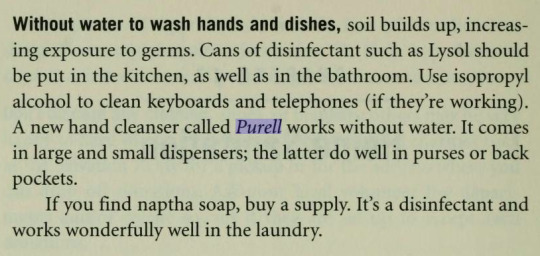
Around 1998, 1999 Bath & Body Works began selling their own hand sanitizer. Because its totally approbate to make a section of a restaurant smell like Juniper Breeze. Looking at you, mom.

Kitchen Lemon is the only suitable scent, and the only scent I bought back then.

ALSO, FOR SOME REASON THERE WAS SOME WITH GLITTER IN IT. BECAUSE IT WAS THE LATE 90S, I GUESS.
[from this amazing Bath & Body Works archive of the old “heartland” days]
Facebook | Etsy | Retail History Blog | Twitter |YouTube Playlist| Random Post | Instagram @ thelastvcr | other tumblr | Ko-fi donation | Honey Referral
1. Porlier, Victor W. Y2K: An Action Plan to Protect Yourself, Your Family, Your Assets, and Your Community on January 1, 2000. 1st ed. New York, NY: HarperCollins, 1999. 50.
2. Angela, Hardin. “Gojo: Getting a Handle on Its Purell Market.” Crain’s Cleveland Business, June 22, 1998.
15 notes
·
View notes
Link
Check out this listing I just added to my Poshmark closet: Vilebrequin Men's Hawaiian Style Swim Trunks - Size 3X.
0 notes
Text
Navigating Muslim Life in the Time of COVID-19 – A Fine Line Between Uncertainty and Panic
By Layla Abdullah-Poulos
At first, I wasn’t scared. News articles referred to it as the coronavirus, a name that has stuck. It seemed far away. Then, the disease spread the globe. I still wasn’t scared, but as I read social media feeds, I could see that a lot of people were.
I went to the stores close to me, rolling my carts by empty shelves where toilet paper, paper towels and water should have been. I stood in long lines, overhearing my fellow shoppers talking about how “bad this thing is.” I saw people frantic about an ominous apocalyptic-like catalyst, signaling the doom of humanity before. So, I figured everyone was in Y2K mode, stocking up to stave off impending destruction.
Embed from Getty Images// <![CDATA[ window.gie=window.gie||function(c){(gie.q=gie.q||[]).push(c)};gie(function(){gie.widgets.load({id:'Yt1dzhNjTzxSk9s8QhmdHg',sig:'WrvX38ka7DcT6gM4diJLi8rBEoAxSnxAtPhsUAnfRDc=',w:'594px',h:'396px',items:'1205498257',caption: true ,tld:'com',is360: false })}); // ]]>
In late February, the Saudi government shut down the holy masajid in Makkah and Madinah to foreign visitors.
I started to take notice. Denying access to two of the three holiest places in Islam was a big deal, especially with Ramadan coming soon. Mosques are space where many Muslims connect with their Creator, and the Prophet (saws) attached special blessings to them:
Whoever goes to the mosque in the morning and evening, Allah will prepare for him a place in Paradise for every morning and evening. Ṣaḥīḥ al-Bukhārī 631, Sahih Muslim 669
Muslim women find many spiritual benefits for attending masajid, and our culture trains Muslim men at an early age about the importance of their presence for daily congregational prayer and Jumu’ah (Friday prayers). The drive to pray in Allah’s house is not easily turned off. The lack of paper products were one thing, but COVID-19 impeded the worship of millions of Muslims and brought with it tough decisions about how to worship.
Masajid around the world continued to close in various capacities. Just now, Saudi Arabia announced, like many other countries, cities and communities, that it was shutting all its mosques for congregational prayers except the Haram mosque in Makkah and the Prophet’s mosque in Madinah.
Does one disregard medical and government warnings and venture into spaces while ill? Is it more pious to do so? Could one’s interpretation of devotion endanger those around them? I went to the closest Islamic source available. Imam Abdul-Lateef Poulos of the Islaamic Center of Mastic-Shirley in Long Island, New York. (Full disclosure, he is my husband.) His answer was straightforward.
“It is not Islamic or devout to put the lives of your fellow Muslims in jeopardy. Everyone deserves to be safe when worshiping Allah (S). Sick people should not come to the masjid. The fiqh is simple when it comes to this.”
His words were sensible and straightforward. However, the reality that his position would probably not resonate with many Muslims – and they will try and come anyway – was tangible and scary. There are Muslims out there who will prioritize their religious habits over everyone’s safety. I shivered for everyone.
The disease started to spread through New York.
The World Health Organization characterized COVID-19 as a pandemic after some hesitancy.
Pandemic is not a word to use lightly or carelessly. It is a word that, if misused, can cause unreasonable fear, or unjustified acceptance that the fight is over, leading to unnecessary suffering and death. – Tedros Adhanom, WHO Director-General
I started reading about thousands of cases in the U.S., and people scrambled to avoid becoming sick, causing shortages of surgical masks and hand sanitizer. A tornado of information swirled on social media. Event cancellations (the NBA season, SXSW festival and countless others), school shutdowns and city containments made knowing what to do or where to go and where not to go (pretty much anywhere) only more confusing.
The containment of the city of New Rochelle, close to where I live, struck hard. My worries ratcheted with the realization that one of my closest’s friends lived there. COVID-19 became more than a viral phantom. It reached from western New York into my county. Sitting back and waiting it out was not an option. Questions raced through my mind as I lay awake at night. How scared should I be?
Embed from Getty Images// <![CDATA[ window.gie=window.gie||function(c){(gie.q=gie.q||[]).push(c)};gie(function(){gie.widgets.load({id:'kKpaEm21SApX84VffVMgFQ',sig:'PdZi9fIy4P2vmDhJz-bWdEAsde7XtALSYtNC-Yesm6c=',w:'508px',h:'339px',items:'506870484',caption: true ,tld:'com',is360: false })}); // ]]>
I consulted professionals.
Fortunately, I was able to talk with infectious disease specialist in Naperville, Ill., Anjum Owaisi, MD. With so much milling through social media and comments by overnight pseudo-epidemiologists and people who suddenly became experts (Read: they are not.), it was important to have a professional help sift through it all. My first question to her was how contagious is COVID-19?
“We are only going to know the real numbers probably in about a year from now. But as it stands, right now, it seems like COVID-19 is more transmittable because it can be spread via droplets [and] persists longer than other viruses.”
Dr. Owaisi gave me some perspective on how much of the agitation about the virus is a tangible concern and how much is general panic.
“We should never panic. Panic is not a good thing. It can lead to bad behaviors. [We] should take the [disease spread] seriously and exercise caution. It has been shown in the 70,000 plus cases in [a China study] that older people, people with chronic health conditions and weakened immune systems fared worse overall; 80 percent of cases had mild to minimal symptoms. Those were people who were younger and don’t have diabetes, heart disease or kidney problems and don’t have a weak immune system.”
She further explained why diseases like COVID-19 hit certain people so hard. “It’s like a stress test on the body. If you’re not healthy, you’re not going to do well on that stress test.”
I spoke with Dr. Owaisi about the communal nature of Islamic life and our worship (Jumu’ah, standing shoulder to shoulder in salah, the congregational breaking of the fast during Ramadan, etc.) and customs like shaking hands, hugging and kissing each other on the cheek, asking her what would be the best course of action for Muslims.
“You have to weigh the risks and benefits. People who are older or with chronic health problems, if this infection persists, then strongly consider using technology to [your] advantage. You can ... do your prayers at home.”
Dr. Owaisi offered advice for people still determined to go to the masjid. “If there are people who definitely want to congregate in the masjid (if one's masjid is still open, which most by this time are not), avoid handshaking and close contact. You can still greet your fellow Muslims with ‘As-salam alaykum,’ but you don’t have to touch them. There are ways you can be part of the Ummah but also stay safe.”
Image source: Pixabay
If you’re younger and otherwise healthy [and] don’t have somebody at home that you are concerned about spreading the disease to or not actively sick, [maintain social distancing and] wash your hands, using hand sanitizer in between. Maintain proper coughing and sneezing etiquette. Continue to be vigilant.”
I asked Dr. Owaisi if Muslim communities should anticipate COVID-19 still being around during Ramadan.
“We don’t know, compared to other respiratory viruses, if improvement of the weather and when people are not [crowded together] indoors that [COVID-19] will die out for the season. The virus that caused COVID-19 acts less like influenza and more like the SARS epidemic of 2003. What concerns us in infectious disease (and also epidemiologists) is that SARS did not die out once the weather got better. It persisted into the summer. We don’t know that [COVID-19] will die out.”
Dr. Owaisi’s final advice connected to the imam’s: “ ... stay home [as much as possible]. Tend to yourself at home. You’re doing yourself and your community a favor.”
Sifting through all of the information out there and concentrating on what will help us plan and prepare to keep our families as safe as possible is critical. COVID-19 may be new, but it is one outbreak on a continuum of disastrous situations threatening humanity.
For more information on COVID-19, visit the Center for Disease Control website.
How are you coping with all the closures, social distancing and quarantining? Share with us in the comments below! Let's support each other.
Navigating Muslim Life in the Time of COVID-19 – A Fine Line Between Uncertainty and Panic published first on https://lenacharms.tumblr.com/
0 notes
Text
Doomsday Bunkers, Gas Masks, and Toilet Paper
Maggie Van (72549331) and Eric Vo (66458368)
When the world found out that the Mayan calendar ended on December 21, 2012, popular culture predicted that life as we know it would cease to exist. There were also numerous instances in history where people thought the world was going to end: Y2K during the year 2000, the Cuban Missile Crisis in 1962, the passing of Halley’s Comet in 1910, and the list goes on. The uncertainty of a catastrophic world-ending event has existed for ages, and with the current political, environmental, and social climate, many have taken preparedness into their own hands. On September 5, 2018, Bloomberg New’s Olivia Carville reported that the Silicon Valley elites’ preparations for the apocalypse include a detailed contingency plan. At the first sign of impending doom, executives plan to promptly exit the U.S to where their luxury bomb shelter awaits, buried deep in the soils of New Zealand.


Source: https://www.bloomberg.com/features/2018-rich-new-zealand-doomsday-preppers/
While some believe that stories like this may just be casual dinner talks over steak and wine, the current pandemic has proven that there are indeed some truths to these sensational headlines. News of the coronavirus outbreak (COVID-19) emerged from Wuhan, China during late December 2019 and quickly began to unravel into a citywide lock-down on January 23, 2020. Despite honest efforts to contain the disease, the coronavirus has now been deemed a pandemic by the WHO, affecting the United States, Italy, South Korea, Japan, and numerous other countries. As of March 12, 2020, there are over 134,000+ confirmed cases and 4,972 deaths worldwide. While some believe that this outbreak is not serious, others are preparing for the unpredictable nature of this virus. The contingency plans of Silicon Valley elites are eerily similar to the cases reported by The Guardian that the wealthy are boarding their private jets to flee from citywide quarantines to holiday homes in other countries to escape the virus, bringing along with them personal doctors and nurses in case that their families become infected.
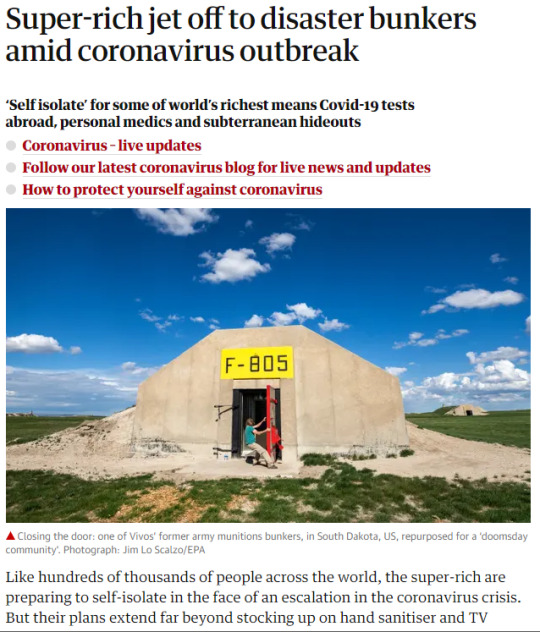
Source: https://www.theguardian.com/world/2020/mar/11/disease-dodging-worried-wealthy-jet-off-to-disaster-bunkers
People who cannot afford these luxuries are taking a different approach to emergency preparedness. As the news began to report that cases are appearing in their countries, people have began hoarding goods in the event that they cannot leave their homes. In Orange County alone, Clorox wipes, toilet paper, masks, gloves, hand sanitizer, and bottled water began flying off the shelves at neighborhood stores such as Target, Walmart, and Costco.

In Figure 1, we illustrated that the fear of toilet paper shortage and lack of drinkable water during a possible countrywide quarantine has increased the demand for these goods as the demand curve shifts from D1 to the right to D2, raising the equilibrium price and quantity. (We did combine the graph for all these goods but it should be read that the graph is an illustration of what is happening to each individual goods since we did not want to create two identical graphs.) At Costco, we began seeing people hoarding toilet paper and water bottles causing supply shortage to the point that there is little to no supply of these goods. The increase in demand has led to shortages and caused Costco and other stores to implement policies to limit the amount of goods that each consumer can purchase.
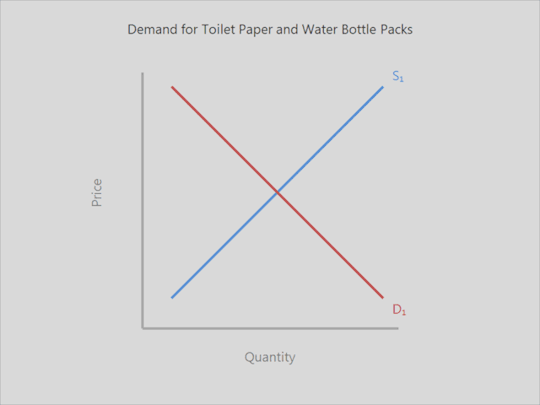
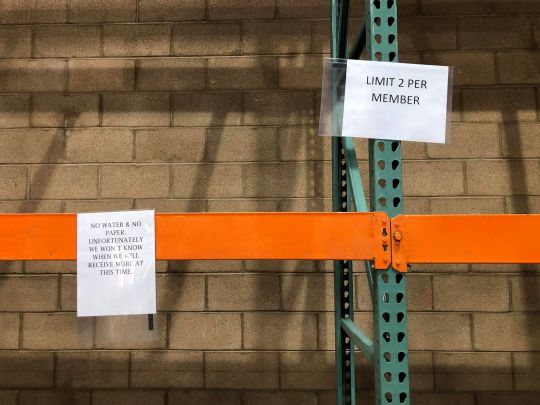
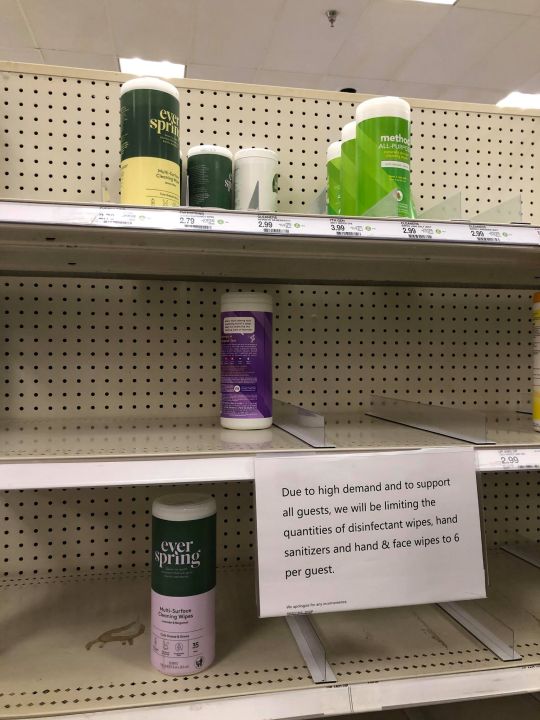
As supplies of Clorox wipes and hand sanitizers began to dwindle, Clorox and Purell are preparing to combat the shortage by investing in more workers and resources to produce enough supply to meet high demands. In Figure 2, we illustrated this by shifting the supply curve from S1 to S2 to the right, increasing the equilibrium quantity and decreasing the equilibrium price. (We did combine the graph for all these goods but it should be read that the graph is an illustration of what is happening to each individual goods.)

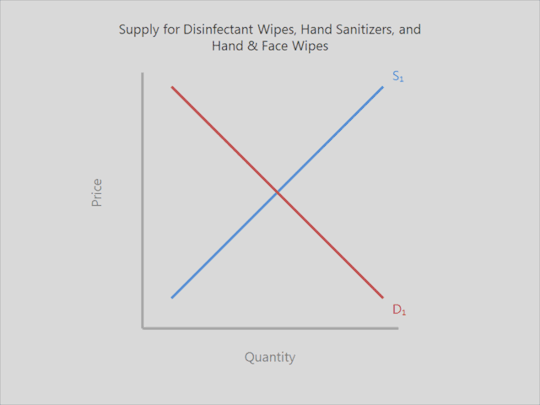
On the other hand, some eager suppliers are beginning to price gouge on essentials such as disinfectant wipes, hand sanitizers, and hand & face wipes since supplies are running low. Life-saving masks are also seeing the effects of price gouging. The problem is rampant in e-commerce that many groups are calling for government intervention from Attorney General Barr to combat the issue. Instead of waiting on government legislation, Amazon, a private company, is actively removing and punishing price gouging on its own platform.
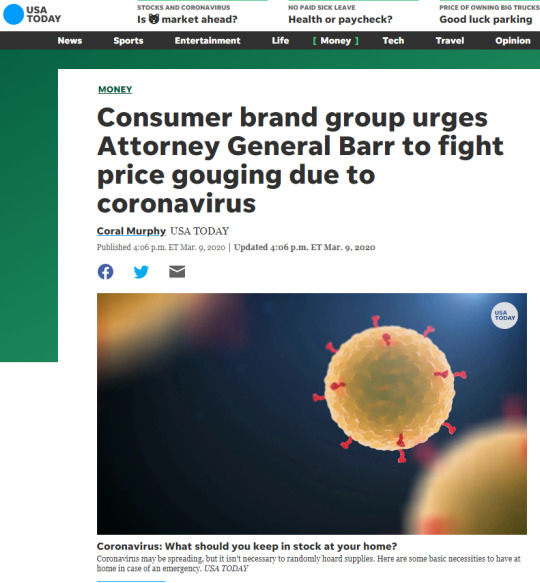
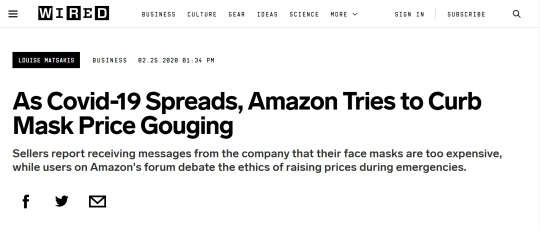
The coronavirus outbreak continues to unravel in the United States and in many other continents as we continue to witness an increase in cases each day. We are in no way criticizing people for stocking up on essentials during these trying times. It is not a big issue to buy some extras on essentials and we think it is a smart thing to do. However, hoarding and price gouging are two issues that must be addressed through government regulations or private means and we can see that the government and private companies are actively trying to combat these issues as the situation progresses. We hope that the situation will be resolved soon and that our peers and the surrounding communities will pull through. In the meantime, wash your hands and be safe!
Bonus: Recently, electronic brand Xiaomi provided medical aid to Italy to help alleviate medical equipment shortages. It is great to see the world coming together to combat the virus even though there are numerous supply chain disruptions!
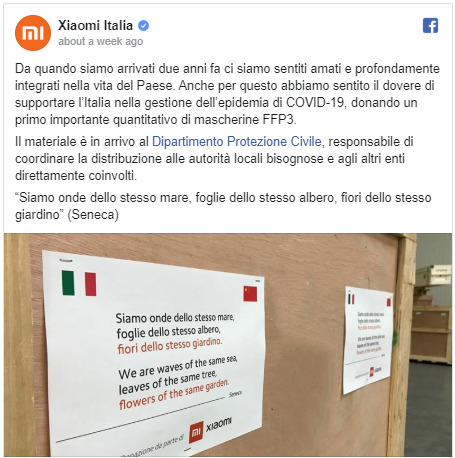
0 notes
Text

Bath and Body Works Country Apple Anti Bacterial Deep Cleansing Hand Gel
late 1990s-early 2000s
Found on Ebay, user paul2cool
#bath and body works country apple#vintage bath and body works#bath and body works country apple anti bacterial hand gel#1990s bath and body works#1990s bath and body works country apple#1990s bath and body works anti bacterial hand gel#1990s bath and body works hand gel#1990s bath and body works anti bacterial#1990s fragrance#1990s country apple#1990s anti bacterial#1990s hand gel#1990 nostalgia#1990s childhood#1990s kids#y2k bath and body works#vintage bath and body works country apple#vintage bath and body works anti bacterial hand gel#vintage bath and body works anti bacterial#vintage bath and body works hand gel#y2k childhood#y2k fragrance#y2k nostalgia#early 2000s country apple#early 2000s bath and body works#early 2000s anti bacterial hand gel#early 2000s bath and body works anti bacterial hand gel#early 2000s bath and body works hand sanitizer#y2k hand sanitizer#1990s hand sanitizer
6 notes
·
View notes
Text
How COVID Colors The Salon Experience
LOVELAND, Colo. — Blush Beauty Bar hair salon had been closed 48 days, a consequence of stay-at-home orders to stem the tide of the COVID-19 pandemic.
But last Tuesday, the shop in this city of nearly 80,000, about 50 miles north of Denver, was finally reopening after the orders had been partially lifted on May 1.
It was booked solid its first day — and for each day the rest of the month. After seven weeks of isolation, it seems people desperately want to get their hair cut.
Still, as Colorado attempts a soft reopening, the three-person staff has had to adjust to a new way of doing business. Even before the salon opened its doors Tuesday, staffers had to rearrange its interior, eliminating the seating in the waiting area, and shifting the front counter to the side, allowing one customer at a time to wait 6 feet away in a spot marked with a blue taped X.
In the final minute before the salon reopened, stylist Diamond Herrera, 22, and receptionist Desi Orr, 19, tested out new no-touch forehead thermometers as owner Mindy Bodley, 40, reminded them of the new procedures.
Email Sign-Up
Subscribe to KHN’s free Morning Briefing.
Sign Up
Please confirm your email address below:
Sign Up
As child care facilities, tattoo parlors and business offices reopen here, they must navigate new government guidelines designed to balance a restart of the economy against the possibility of reigniting the pandemic, all without scaring away customers. Indeed, a late April survey by Healthier Colorado and The Colorado Health Foundation found that 64% of Coloradans support a policy of staying home to slow the spread of the coronavirus, even if that means businesses will remain closed.
At 10 a.m., Orr stepped outside to meet their first customer, Amy Eldridge, 45, who had called from her car to announce her arrival. Orr used the new thermometer to confirm Eldridge didn’t have a fever, and then checked whether she had brought a face mask. Customers can also purchase a cloth one for $10 when they arrive.
“Have you been sick in the last 14 days?” Orr asked her. “Have you been around anyone who has been sick in the last 14 days? Do you have any flu-like symptoms?”
Replying no to all three, Eldridge was allowed inside. But the first glitch emerged when Orr realized the door had locked behind her. It was part of the new protocol: No walk-in customers are allowed, so the door stays locked.
Once inside, Eldridge was asked to wash her hands before sitting down in the black leather salon chair, placing her purse and keys into a plastic box beside her.
“So how are things?” Bodley asked her as she prepared to cut Eldridge’s hair.
“They’re good!” Eldridge replied.
Blush Beauty Bar hair salon in Loveland, Colorado, has been swamped with clients coming in for haircuts, trims and color, now that the state is gradually reopening after its COVID-19 shutdown. Amy Eldridge was first among them.(Markian Hawryluk/KHN)
And at least for the moment, it all felt familiar. She had made the appointment seven months earlier and now her strawberry-blonde hair had reached down to the middle of her back. Eldridge couldn’t have known last fall that the salon would close down for seven weeks due to a never-before-seen virus that would shut down the nation’s economy and keep most people sheltered at home and desperate for a haircut.
“I’ve worked from home for 15 years, so for me this hasn’t been a big change. And I only get my hair cut twice a year,” Eldridge said. “But at the same time, I get so excited about my appointments.”
Eldridge has known Bodley for more than a decade, which removed any fears of coming to the salon.
“I have total trust in Mindy, and not just for my hair,” she said, as Bodley went to mix some hair dye for her. “I know she always has her customers’ safety in mind. She wouldn’t do anything to compromise her customers or her business.”
Soon after, Macall McFall, 26, arrived to get her long brown hair colored before her graduation from an occupational therapy program next week.
“We’re having a virtual graduation,” McFall said, with a note of disappointment.
The Blush experience, where a visit can cost $150 or more, is still the same pampering extravagance it has always been, with a few minor tweaks. Both the customers and the stylists must wear masks the entire time, and Bodley and Herrera work in hot-pink rubber gloves they previously used only for messy jobs like dyeing.
They no longer offer beverages to customers and won’t sit next to them to chat as they wait for the dye to set. The salon is no longer taking glamour photos of clients sporting their new looks amid special lighting and backdrops. And they can fit in fewer appointments per day given the new safety steps.
It all was an adjustment for both stylist and customer.
“I feel like I can’t see,” Bodley said at one point as the mask rode up while working on Eldridge’s hair. “It’s sort of important to my job.”
The COVID pandemic colored all aspects of the experience including the friendly banter at the salon. Instead of complimenting a customer’s blouse or shoes, Herrera admired McFall’s blue-patterned face mask. “It’s so cute!”
The women shared their quarantine stories and updated one another on Netflix shows they had binge-watched at home: from “Waco” to “Dance Moms” and, of course, “Tiger King.” There was a broad consensus that Carole Baskin had killed her previous husband.
Blush has been open for four years at its 4th Street location, just off the city’s main drag. Bodley has a loyal customer base as evidenced by the “Best Salon in Loveland” certificates, awarded by readers of the local newspaper, hanging on the wall. Still, once the virus appeared in the U.S. and made its way to Colorado, business had started to slow.
“Our numbers have been down this year,” Bodley said. “You never know what people will be scared of, but the beauty industry, hair, is usually a recession-proof business.”
At first, she didn’t know what to make of the slowdown, even as many of her friends were starting to stockpile toilet paper, hand sanitizer and flour and preparing for a lockdown.
“I prepared for Y2K,” Bodley recalled thinking. “I am not preparing for this.”
But by March, customers were canceling appointments. Phone alerts would buzz in the middle of haircuts, informing customers their child’s school was closing or some other routine aspect of their family’s life was shutting down.
Then on March 18, Bodley learned the state was shutting down nonessential businesses. She finished with the client she had in her salon at the time, squeezed in her best friend for one last appointment, and then closed up shop. She locked the door and took the salon’s last three rolls of toilet paper home with her.
Bodley’s husband orders beer for a liquor store, which was deemed an essential industry in Colorado, so he continued to work. The dog supply store Bodley owns next to the salon was able to shift to online sales. And she did receive a $2,000 Economic Injury Disaster Loan. But she still has rent and bills to pay.
“I am relieved to be back working,” she admitted. “This month will be a push. We have to cover May and June.”
Besides the restaurants and coffee shops that shifted to takeout services to stay open during the closure, most of the other retail businesses remained closed even though the state was slowly reopening.
“It’s a ghost town,” Bodley said. “I live on this street and I’ve never had so much parking.”
Still, the first day back was all smiles, even if they were hidden behind face masks; a hint that life could return to some semblance of pre-pandemic patterns, even if so much of the future remains clouded.
“I’m ready for Marshalls to open,” Bodley said. “I miss the people, but I didn’t really miss working. I thought, ‘How are we surviving?’ It’s because nothing is open for me to spend money on!”
Eldridge agreed.
“Our checkbook has seen some serious healing,” she said.
As she trimmed inches off Eldridge’s hair, Bodley admitted that “cutting hair in gloves is not cool. We already know I can’t see.”
Herrera had similar challenges as she dried McFall’s hair.
“I’m hoping it’s dry,” she said. “I can’t feel.”
But those hurdles were a small price to pay.
“I’m just happy to be here,” McFall said as she checked the new hue of her long hair in the mirror. “I love it! It looks so good!”
She moved to the counter to pay her bill, stretching her arm as far she could to hand Herrera her credit card to try to maintain the proper distance.
When McFall left, Herrera sprayed disinfectant on the chair, the counter and the plastic bin that had held her personal items. She wiped down the hand mirror her client had held. In other times, it would seem odd, almost insulting, to take such measures.
But the pandemic has altered nearly every part of normal life, even something as routine as a haircut, and nobody knows for how long.
“This could be our new normal,” Herrera said.
How COVID Colors The Salon Experience published first on https://smartdrinkingweb.weebly.com/
0 notes
Text
How COVID Colors The Salon Experience
LOVELAND, Colo. — Blush Beauty Bar hair salon had been closed 48 days, a consequence of stay-at-home orders to stem the tide of the COVID-19 pandemic.
But last Tuesday, the shop in this city of nearly 80,000, about 50 miles north of Denver, was finally reopening after the orders had been partially lifted on May 1.
It was booked solid its first day — and for each day the rest of the month. After seven weeks of isolation, it seems people desperately want to get their hair cut.
Still, as Colorado attempts a soft reopening, the three-person staff has had to adjust to a new way of doing business. Even before the salon opened its doors Tuesday, staffers had to rearrange its interior, eliminating the seating in the waiting area, and shifting the front counter to the side, allowing one customer at a time to wait 6 feet away in a spot marked with a blue taped X.
In the final minute before the salon reopened, stylist Diamond Herrera, 22, and receptionist Desi Orr, 19, tested out new no-touch forehead thermometers as owner Mindy Bodley, 40, reminded them of the new procedures.
Email Sign-Up
Subscribe to KHN’s free Morning Briefing.
Sign Up
Please confirm your email address below:
Sign Up
As child care facilities, tattoo parlors and business offices reopen here, they must navigate new government guidelines designed to balance a restart of the economy against the possibility of reigniting the pandemic, all without scaring away customers. Indeed, a late April survey by Healthier Colorado and The Colorado Health Foundation found that 64% of Coloradans support a policy of staying home to slow the spread of the coronavirus, even if that means businesses will remain closed.
At 10 a.m., Orr stepped outside to meet their first customer, Amy Eldridge, 45, who had called from her car to announce her arrival. Orr used the new thermometer to confirm Eldridge didn’t have a fever, and then checked whether she had brought a face mask. Customers can also purchase a cloth one for $10 when they arrive.
“Have you been sick in the last 14 days?” Orr asked her. “Have you been around anyone who has been sick in the last 14 days? Do you have any flu-like symptoms?”
Replying no to all three, Eldridge was allowed inside. But the first glitch emerged when Orr realized the door had locked behind her. It was part of the new protocol: No walk-in customers are allowed, so the door stays locked.
Once inside, Eldridge was asked to wash her hands before sitting down in the black leather salon chair, placing her purse and keys into a plastic box beside her.
“So how are things?” Bodley asked her as she prepared to cut Eldridge’s hair.
“They’re good!” Eldridge replied.
Blush Beauty Bar hair salon in Loveland, Colorado, has been swamped with clients coming in for haircuts, trims and color, now that the state is gradually reopening after its COVID-19 shutdown. Amy Eldridge was first among them.(Markian Hawryluk/KHN)
And at least for the moment, it all felt familiar. She had made the appointment seven months earlier and now her strawberry-blonde hair had reached down to the middle of her back. Eldridge couldn’t have known last fall that the salon would close down for seven weeks due to a never-before-seen virus that would shut down the nation’s economy and keep most people sheltered at home and desperate for a haircut.
“I’ve worked from home for 15 years, so for me this hasn’t been a big change. And I only get my hair cut twice a year,” Eldridge said. “But at the same time, I get so excited about my appointments.”
Eldridge has known Bodley for more than a decade, which removed any fears of coming to the salon.
“I have total trust in Mindy, and not just for my hair,” she said, as Bodley went to mix some hair dye for her. “I know she always has her customers’ safety in mind. She wouldn’t do anything to compromise her customers or her business.”
Soon after, Macall McFall, 26, arrived to get her long brown hair colored before her graduation from an occupational therapy program next week.
“We’re having a virtual graduation,” McFall said, with a note of disappointment.
The Blush experience, where a visit can cost $150 or more, is still the same pampering extravagance it has always been, with a few minor tweaks. Both the customers and the stylists must wear masks the entire time, and Bodley and Herrera work in hot-pink rubber gloves they previously used only for messy jobs like dyeing.
They no longer offer beverages to customers and won’t sit next to them to chat as they wait for the dye to set. The salon is no longer taking glamour photos of clients sporting their new looks amid special lighting and backdrops. And they can fit in fewer appointments per day given the new safety steps.
It all was an adjustment for both stylist and customer.
“I feel like I can’t see,” Bodley said at one point as the mask rode up while working on Eldridge’s hair. “It’s sort of important to my job.”
The COVID pandemic colored all aspects of the experience including the friendly banter at the salon. Instead of complimenting a customer’s blouse or shoes, Herrera admired McFall’s blue-patterned face mask. “It’s so cute!”
The women shared their quarantine stories and updated one another on Netflix shows they had binge-watched at home: from “Waco” to “Dance Moms” and, of course, “Tiger King.” There was a broad consensus that Carole Baskin had killed her previous husband.
Blush has been open for four years at its 4th Street location, just off the city’s main drag. Bodley has a loyal customer base as evidenced by the “Best Salon in Loveland” certificates, awarded by readers of the local newspaper, hanging on the wall. Still, once the virus appeared in the U.S. and made its way to Colorado, business had started to slow.
“Our numbers have been down this year,” Bodley said. “You never know what people will be scared of, but the beauty industry, hair, is usually a recession-proof business.”
At first, she didn’t know what to make of the slowdown, even as many of her friends were starting to stockpile toilet paper, hand sanitizer and flour and preparing for a lockdown.
“I prepared for Y2K,” Bodley recalled thinking. “I am not preparing for this.”
But by March, customers were canceling appointments. Phone alerts would buzz in the middle of haircuts, informing customers their child’s school was closing or some other routine aspect of their family’s life was shutting down.
Then on March 18, Bodley learned the state was shutting down nonessential businesses. She finished with the client she had in her salon at the time, squeezed in her best friend for one last appointment, and then closed up shop. She locked the door and took the salon’s last three rolls of toilet paper home with her.
Bodley’s husband orders beer for a liquor store, which was deemed an essential industry in Colorado, so he continued to work. The dog supply store Bodley owns next to the salon was able to shift to online sales. And she did receive a $2,000 Economic Injury Disaster Loan. But she still has rent and bills to pay.
“I am relieved to be back working,” she admitted. “This month will be a push. We have to cover May and June.”
Besides the restaurants and coffee shops that shifted to takeout services to stay open during the closure, most of the other retail businesses remained closed even though the state was slowly reopening.
“It’s a ghost town,” Bodley said. “I live on this street and I’ve never had so much parking.”
Still, the first day back was all smiles, even if they were hidden behind face masks; a hint that life could return to some semblance of pre-pandemic patterns, even if so much of the future remains clouded.
“I’m ready for Marshalls to open,” Bodley said. “I miss the people, but I didn’t really miss working. I thought, ‘How are we surviving?’ It’s because nothing is open for me to spend money on!”
Eldridge agreed.
“Our checkbook has seen some serious healing,” she said.
As she trimmed inches off Eldridge’s hair, Bodley admitted that “cutting hair in gloves is not cool. We already know I can’t see.”
Herrera had similar challenges as she dried McFall’s hair.
“I’m hoping it’s dry,” she said. “I can’t feel.”
But those hurdles were a small price to pay.
“I’m just happy to be here,” McFall said as she checked the new hue of her long hair in the mirror. “I love it! It looks so good!”
She moved to the counter to pay her bill, stretching her arm as far she could to hand Herrera her credit card to try to maintain the proper distance.
When McFall left, Herrera sprayed disinfectant on the chair, the counter and the plastic bin that had held her personal items. She wiped down the hand mirror her client had held. In other times, it would seem odd, almost insulting, to take such measures.
But the pandemic has altered nearly every part of normal life, even something as routine as a haircut, and nobody knows for how long.
“This could be our new normal,” Herrera said.
from Updates By Dina https://khn.org/news/how-covid-colors-the-salon-experience/
0 notes
Text
How COVID Colors The Salon Experience
LOVELAND, Colo. — Blush Beauty Bar hair salon had been closed 48 days, a consequence of stay-at-home orders to stem the tide of the COVID-19 pandemic.
But last Tuesday, the shop in this city of nearly 80,000, about 50 miles north of Denver, was finally reopening after the orders had been partially lifted on May 1.
It was booked solid its first day — and for each day the rest of the month. After seven weeks of isolation, it seems people desperately want to get their hair cut.
Still, as Colorado attempts a soft reopening, the three-person staff has had to adjust to a new way of doing business. Even before the salon opened its doors Tuesday, staffers had to rearrange its interior, eliminating the seating in the waiting area, and shifting the front counter to the side, allowing one customer at a time to wait 6 feet away in a spot marked with a blue taped X.
In the final minute before the salon reopened, stylist Diamond Herrera, 22, and receptionist Desi Orr, 19, tested out new no-touch forehead thermometers as owner Mindy Bodley, 40, reminded them of the new procedures.
Email Sign-Up
Subscribe to KHN’s free Morning Briefing.
Sign Up
Please confirm your email address below:
Sign Up
As child care facilities, tattoo parlors and business offices reopen here, they must navigate new government guidelines designed to balance a restart of the economy against the possibility of reigniting the pandemic, all without scaring away customers. Indeed, a late April survey by Healthier Colorado and The Colorado Health Foundation found that 64% of Coloradans support a policy of staying home to slow the spread of the coronavirus, even if that means businesses will remain closed.
At 10 a.m., Orr stepped outside to meet their first customer, Amy Eldridge, 45, who had called from her car to announce her arrival. Orr used the new thermometer to confirm Eldridge didn’t have a fever, and then checked whether she had brought a face mask. Customers can also purchase a cloth one for $10 when they arrive.
“Have you been sick in the last 14 days?” Orr asked her. “Have you been around anyone who has been sick in the last 14 days? Do you have any flu-like symptoms?”
Replying no to all three, Eldridge was allowed inside. But the first glitch emerged when Orr realized the door had locked behind her. It was part of the new protocol: No walk-in customers are allowed, so the door stays locked.
Once inside, Eldridge was asked to wash her hands before sitting down in the black leather salon chair, placing her purse and keys into a plastic box beside her.
“So how are things?” Bodley asked her as she prepared to cut Eldridge’s hair.
“They’re good!” Eldridge replied.
Blush Beauty Bar hair salon in Loveland, Colorado, has been swamped with clients coming in for haircuts, trims and color, now that the state is gradually reopening after its COVID-19 shutdown. Amy Eldridge was first among them.(Markian Hawryluk/KHN)
And at least for the moment, it all felt familiar. She had made the appointment seven months earlier and now her strawberry-blonde hair had reached down to the middle of her back. Eldridge couldn’t have known last fall that the salon would close down for seven weeks due to a never-before-seen virus that would shut down the nation’s economy and keep most people sheltered at home and desperate for a haircut.
“I’ve worked from home for 15 years, so for me this hasn’t been a big change. And I only get my hair cut twice a year,” Eldridge said. “But at the same time, I get so excited about my appointments.”
Eldridge has known Bodley for more than a decade, which removed any fears of coming to the salon.
“I have total trust in Mindy, and not just for my hair,” she said, as Bodley went to mix some hair dye for her. “I know she always has her customers’ safety in mind. She wouldn’t do anything to compromise her customers or her business.”
Soon after, Macall McFall, 26, arrived to get her long brown hair colored before her graduation from an occupational therapy program next week.
“We’re having a virtual graduation,” McFall said, with a note of disappointment.
The Blush experience, where a visit can cost $150 or more, is still the same pampering extravagance it has always been, with a few minor tweaks. Both the customers and the stylists must wear masks the entire time, and Bodley and Herrera work in hot-pink rubber gloves they previously used only for messy jobs like dyeing.
They no longer offer beverages to customers and won’t sit next to them to chat as they wait for the dye to set. The salon is no longer taking glamour photos of clients sporting their new looks amid special lighting and backdrops. And they can fit in fewer appointments per day given the new safety steps.
It all was an adjustment for both stylist and customer.
“I feel like I can’t see,” Bodley said at one point as the mask rode up while working on Eldridge’s hair. “It’s sort of important to my job.”
The COVID pandemic colored all aspects of the experience including the friendly banter at the salon. Instead of complimenting a customer’s blouse or shoes, Herrera admired McFall’s blue-patterned face mask. “It’s so cute!”
The women shared their quarantine stories and updated one another on Netflix shows they had binge-watched at home: from “Waco” to “Dance Moms” and, of course, “Tiger King.” There was a broad consensus that Carole Baskin had killed her previous husband.
Blush has been open for four years at its 4th Street location, just off the city’s main drag. Bodley has a loyal customer base as evidenced by the “Best Salon in Loveland” certificates, awarded by readers of the local newspaper, hanging on the wall. Still, once the virus appeared in the U.S. and made its way to Colorado, business had started to slow.
“Our numbers have been down this year,” Bodley said. “You never know what people will be scared of, but the beauty industry, hair, is usually a recession-proof business.”
At first, she didn’t know what to make of the slowdown, even as many of her friends were starting to stockpile toilet paper, hand sanitizer and flour and preparing for a lockdown.
“I prepared for Y2K,” Bodley recalled thinking. “I am not preparing for this.”
But by March, customers were canceling appointments. Phone alerts would buzz in the middle of haircuts, informing customers their child’s school was closing or some other routine aspect of their family’s life was shutting down.
Then on March 18, Bodley learned the state was shutting down nonessential businesses. She finished with the client she had in her salon at the time, squeezed in her best friend for one last appointment, and then closed up shop. She locked the door and took the salon’s last three rolls of toilet paper home with her.
Bodley’s husband orders beer for a liquor store, which was deemed an essential industry in Colorado, so he continued to work. The dog supply store Bodley owns next to the salon was able to shift to online sales. And she did receive a $2,000 Economic Injury Disaster Loan. But she still has rent and bills to pay.
“I am relieved to be back working,” she admitted. “This month will be a push. We have to cover May and June.”
Besides the restaurants and coffee shops that shifted to takeout services to stay open during the closure, most of the other retail businesses remained closed even though the state was slowly reopening.
“It’s a ghost town,” Bodley said. “I live on this street and I’ve never had so much parking.”
Still, the first day back was all smiles, even if they were hidden behind face masks; a hint that life could return to some semblance of pre-pandemic patterns, even if so much of the future remains clouded.
“I’m ready for Marshalls to open,” Bodley said. “I miss the people, but I didn’t really miss working. I thought, ‘How are we surviving?’ It’s because nothing is open for me to spend money on!”
Eldridge agreed.
“Our checkbook has seen some serious healing,” she said.
As she trimmed inches off Eldridge’s hair, Bodley admitted that “cutting hair in gloves is not cool. We already know I can’t see.”
Herrera had similar challenges as she dried McFall’s hair.
“I’m hoping it’s dry,” she said. “I can’t feel.”
But those hurdles were a small price to pay.
“I’m just happy to be here,” McFall said as she checked the new hue of her long hair in the mirror. “I love it! It looks so good!”
She moved to the counter to pay her bill, stretching her arm as far she could to hand Herrera her credit card to try to maintain the proper distance.
When McFall left, Herrera sprayed disinfectant on the chair, the counter and the plastic bin that had held her personal items. She wiped down the hand mirror her client had held. In other times, it would seem odd, almost insulting, to take such measures.
But the pandemic has altered nearly every part of normal life, even something as routine as a haircut, and nobody knows for how long.
“This could be our new normal,” Herrera said.
How COVID Colors The Salon Experience published first on https://nootropicspowdersupplier.tumblr.com/
0 notes
Quote
So it's 1960 and Louisville Water goes: 'hey the sewer system is more than a half century old, it's time to begin planning a replacement' but residents are like 'taxes are the devil and your mom is a whore' so nothing gets done. 1970 rolls around and white flight is in full force. People are heading out to the burbs and building new subdivisions in J county and running around going 'look at my yard and my ugly dog; everything is wonderful.' And Louisville Water goes, 'it's wonderful on the surface but we still need to replace the old sewer and now we have hundreds of miles of new water and sewer lines that are further stressing the old system. Everyone needs to chip in,' except residents go, 'I'll ship your water-loving ass off to 'nam and you can figure out how to fix this problem while having no legs.' Before you know it, 1980 descends upon us and it's all hostage this, recession that. And with the 1980s comes malls and strip malls and malls with strip clubs. And more pipes. Oh and Nixon created this thing called the EPA and by then they realized that the Ohio river is gross and pumping leftover raw sewage might not be smart. But Chambliss and Bridgette don't want to hear any of that libtard shit and aren't going to pay a tax increase as it cuts into their water skiiing budget. Meanwhile, their son Beaufort has some development disabilities because he got baptized with water that wasn't properly treated. God works in mysterious ways, indeed. Buckle up because it's 1990 and shit's about to get wild. The core of Louisville is desolate and the burbs are booming, but all those pipes are still needed to do their job and they are woefully out of date. But who fucking cares! Stormin' Norman Schwartzkopff just destroyed the Iraqi army so who needs water when you can drink cheap-ass oil. Meanwhile the EPA is starting to to let cities know that things aren't great. Unfortunately no one is listening in 2000 because OMG Y2K. Then tech crash. And then 9-11. Then freedom fries. Then stocks go poop. Then recession goes BOOM. Then fuck. Then the EPA goes CLEAN YOUR FUCKING SHIT UP like a mom who can't stand to look at her kid's room any longer. And so in 210 now we have more people and all their new pipes that feed into the old pipes. And those pipes are failing. And all the hipster mustache hairs are clogging old mains. So we need to replace the whole system. We also need to build a system that literally stores our shit so that when it rains to much we won't pump it into the rivers and instead will treat it during drier days of the month. And Darren and Kayla are part of gentrification nation and are ready to revitalize the city core with a fixer upper. Except they are a 'hard pass' when it comes to germs so not only do they have hand sanitizers in every room (along with vintage PBR signs), but they love themselves some flushable wipes. Except those things wreak absolute havoc on sewers and treatment systems. How much havoc? Enough that cities are suing to have them banned from being sold. Oh, also we like to freeze and thaw a lot during the winters which can lead to pipe failures. But what didn't happen was some magic poop fairly waving a dookie wand and that replaced the whole system free of cost. What DID happen was pressure from the federal government and local government and common sense that forced the issue and so we all have to pay for it now.
u/santaslate explains why your water bill is so high on Reddit
0 notes
Text
Mit Depop Live in New York City wird der Online-Marktplatz zum Leben erweckt
https://de.bufinans.com/mit-depop-live-in-new-york-city-wird-der-online-marktplatz-zum-leben-erweckt/?wpwautoposter=1560268111 Mit Depop Live in New York City wird der Online-Marktplatz zum Leben erwecktGeschäftsideen - Bufinanshttps://de.bufinans.com/mit-depop-live-in-new-york-city-wird-der-online-marktplatz-zum-leben-erweckt/?wpwautoposter=1560268111 Die einwöchige Veranstaltung hat dazu beigetragen, die starke Community der Gen-Z-Modeunternehmer auf der digitalen Plattform zu fördern und zu stärken. Am Freitagabend schlängelte sich eine Linie um die Ecke von Broadway und Howard St. in New Yorks Soho, während verschiedene Cliquen und Crews von Very Stylish People auf ihre Chance warteten Depop Live, die erste Wochenendveranstaltung des Online-Marktplatzes, die von Samstag bis Sonntag offiziell kostenlos für die Öffentlichkeit geöffnet wurde. Ein älterer Herr – höchstwahrscheinlich ein Tourist, der am Canal St. vorbeiging – fragte die Publizisten am Eingang, wofür genau die lange Schlange sei. Mit Klemmbrettern, RSVP-Listen und Armbändern bewaffnet, während sie mögliche Gatecrashers einsetzten, antworteten diejenigen, die an der Tür arbeiteten, nicht so schnell. In der Tat war es wahrscheinlich das Beste, nicht zu verraten, was genau der rotgeladene Partyraum feierte. Wenn du wüsstest, wüsstest du es. In Verbindung stehende ArtikelSo verdienen Sie Ihren Lebensunterhalt mit Wiederverkaufsseiten2018 war das Jahr des Wiederverkaufs MainstreamHier sind die Modeartikel, die Sie diesen Frühling einliefern sollten, wenn Sie den besten Dollar verdienen möchten Danke fürs zuschauen!Besuche die Website Laut CMO Peter Semple ist Depop Live seit Ende letzten Jahres in Arbeit, um den Erfolg von zu kennzeichnen sein Geschäft in den USA und wie sehr es sich seit seinem Eintritt in den amerikanischen Markt im Jahr 2014 entwickelt hat. (Das Unternehmen wurde ursprünglich 2011 in Mailand gegründet und hat derzeit seinen Sitz in London.) "Das Geschäft ist bereits seit einigen Jahren in Amerika tätig, und wir haben ein kleines Unternehmen physischer Einzelhandel hier in New York und ein kleiner physischer Einzelhandel in (Los Angeles)und es schien, als gäbe es eine Zeit, um etwas viel Größeres anzuziehen und einige der kreativen Gemeinschaften wirklich zu feiern ", sagt Semple. Danke fürs zuschauen!Besuche die Website Danke fürs zuschauen!Besuche die Website Besucher kaufen Depop Live 2019 in New York City. Foto: Mike Vitelli / BFA.com, mit freundlicher Genehmigung von Depop "Wir haben nur auf den richtigen Zeitpunkt gewartet", fügt CEO Maria Raga hinzu. "Und letztes Jahr war für uns ein sehr starkes Jahr, um ein Produkt zu finden, das in diesen Markt passt. Jetzt ist es an der Zeit, wirklich etwas Großes zu tun, im Gegensatz zu vor zwei Jahren, als wir noch keine Community hatten Jetzt haben wir 200.000 Verkäufer in den USA, zwei Geschäfte und fünf Millionen registrierte Benutzer. Es war der Moment zu sagen: "Wir sind hier, das ist, was wir tun, das ist, worum es bei Depop geht." Erst vor ungefähr drei Monaten nahm die Idee für Depop Live die Form des letzten Wochenendes an: zwei Tage voller eindringlicher Erlebnisse, die dazu beitragen, die starke (und stark von Gen-Z geprägte) Community der Modeunternehmer zu stärken und zu stärken . Das Unternehmen lud 50 seiner Bestseller und Lieblingsverkäufer ein, sich in den von Depop angemieteten Räumen niederzulassen, die in einige der Hauptkategorien der App unterteilt waren: Y2K, Vintage, Streetwear und Second-Hand-Designer. Eine Reihe von Marken, die die New Yorker Innenstadt bedienen, standen ebenfalls zum Verkauf, darunter Telfar, Sandy Liang, Infinite Resort, Nicole Saldaña, Miaou und Kein Sesso, die auch eine Marke für ein Instagram-freundliches ATV, das für die gesamte Veranstaltung ausgestellt war. Jeder Artikel – von denen es insgesamt mehr als 1.500 gab – war mit einem Preisschild versehen, das die Depop-Seiteninformationen des Verkäufers enthielt. Transaktionen wurden von betrieben Paypal und diejenigen mit Depop-Konten erhielten einen Sonderrabatt. Auch Musik, Künstlerinstallationen, Tafeln und Workshops sorgten für Unterhaltung. Am Samstagnachmittag leitete der DIY-Mode-Guru Left Hand LA einen Workshop zum Thema Nähflicken, und am Abend veranstaltete die Gründerin von Everybody.World, Iris Alonzo, ein Podium zum Thema Transparenz. Nachhaltigkeit und Aktivismus in der Modebranche mit den Designern Nicole McLaughlin, Reiher Preston und die stellvertretende Kommissarin für Recycling und Nachhaltigkeit, Bridget Anderson, vom NYC Department of Sanitation. Am Sonntag gab es einen Siebdruck mit Sonya Sombreuil von Come Tees und Raga veranstaltete eine Podiumsdiskussion zum Aufbau eines erfolgreichen Geschäfts mit Fotografen Tyler Mitchell, Instagram-Style-Star Gully Guy Leo und Bella McFadden, auch bekannt als Internet-Mädchen und das inoffizielle Aushängeschild von Depop. Eine DIY-Aktivierungsstation bei Depop Live 2019 in New York City. Foto: Madison Voelkel / BFA.com, mit freundlicher Genehmigung von Depop "Es ist so erstaunlich und so liebevoll und unterstützend", sagt McFadden von der Depop-Community. "Ich liebe Depop, weil Es ist eine E-Commerce-App, aber auch eine Social-Media-PlattformDadurch wird das gesamte Einkaufserlebnis nahtlos, freundlich und großartig. "McFadden begann 2016 mit der Verwendung von Depop als eher" lässige Sache "und verkaufte Kleidung, die sie in der Schulpause nicht mehr so oft trug Als es an der Zeit war zu entscheiden, ob sie zu ihrem nächsten College-Semester zurückkehren würde, entschied sie sich stattdessen für Depop. "Ich habe es so gut gemacht, dass ich weiterverkaufen wollte. Am Ende habe ich mich ganztägig von Depop verabschiedet", sagt McFadden. "In den letzten Jahren habe ich zufällige Kleidungsstücke aus meiner Garderobe verkauft, um Entwürfe zu machen, und einen internationalen Styling-Service, den ich jetzt bei Depop verkaufen kann." Vor ungefähr sieben Monaten entwurzelte sie ihr Leben in ihrer Heimatstadt in Kanada und zog nach LA, wo sie ihr eigenes Büro eröffnete. Aber McFaddens Erfolgsgeschichte ist in der Depop-Welt nicht ungewöhnlich, besonders als Wiederverkauf wird mehr Mainstream und Machtverkäufer fangen an, ihren Lebensunterhalt zu verdienen in ihren eigenen Online-Geschäften. Johnny Grummons, der Vintage- und Gebrauchtwaren über verkauft @ guccig11 aus Omaha, Neb., entschied sich ebenfalls, das College für Depop aufzugeben. "Ich war davon besessen", sagt er. "Jeden Tag, egal was, egal wie ich mich fühlte, wachte ich auf, machte den ganzen Tag Sparsamkeit, kam nach Hause, machte Fotos von allem, postete es, packte es ein – vielleicht eineinhalb Jahre Arbeit das, und es hat mich so weit gebracht, also ist es ziemlich genial. " Von links: Tyler Mitchell, Bella McFadden, Gully Guy Leo und Maria Raga auf einem Panel für Depop Live 2019 in New York City. Foto: Madison Voelkel / BFA.com, mit freundlicher Genehmigung von Depop Für Grummons noch recht jungen Laden schafft er es, mindestens vier Verkäufe pro Tag zu tätigen, was einem Mindestgewinn von 1.200 USD pro Woche entspricht (nach Zahlung und Versandkosten). Während die meisten seiner Stücke zwischen 10 und 30 US-Dollar liegen, kam der höchste Verkauf bisher von einer Harley Davidson 3D-Emblem-Figur für 360 US-Dollar. "(Depop Live) zeigt die unglaubliche Breite und Vielfalt dieser Art von Kreativität, die von einer wirklich jungen Generation kommt", sagt Semple. "Wir lieben die Tatsache, dass wir uns sehr auf Gen Z konzentrieren, weil Sie all diese jungen Kreativen haben. Sie formen alles neu. Sie formen soziale Werte, Kreativität, Unternehmertum neu und sehen, wie sie sich auf unterschiedliche Weise durchsetzen." Mode." Bisher wurde das eigene Geschäft von Depop als Erfolg gewertet, da die Live-Veranstaltung direkt hinter dem Unternehmen eintraf Serie C-Finanzierung, die 62 Millionen US-Dollar einbrachte. (Der Online-Marktplatz mit 13 Millionen Nutzern weltweit will in den USA und auf internationaler Ebene expandieren, in neue Tools und Funktionen für seine Plattform investieren sowie seine Ingenieure und Data Science-Teams erweitern.) Mit Der jüngste Börsengang von Revolve und The Real Real's Einreichung In der vergangenen Woche hat der E-Commerce gerade viel Aufmerksamkeit erhalten. Es ist kaum zu überlegen, ob ein ähnlicher Geschäftsverlauf in der Zukunft von Depop liegen könnte. "Wir sind im Moment sehr an der Serie C interessiert", sagt Raga. "Es ist interessant zu sehen, was mit anderen Unternehmen passiert, aber die Zeit wird es (für uns) zeigen." Derzeit konzentriert sich das Team auf den Erfolg von Depop Live, das laut einem Unternehmenssprecher mehr als 3.000 Besucher begrüßte und einen Umsatz von "über Zehntausenden von Dollar" erzielte. "New York und LA sind unsere größten Städte, und eines der Dinge, die wir tun möchten, insbesondere aufgrund unserer Finanzierung, ist es, über diese großen Städte hinaus zu expandieren", sagt Raga. "Wir haben bereits eine Menge Verkäufer in der Mitte von Amerika, aber wir möchten solche Konzepte entwickeln und auf andere Regionen ausweiten. Letztendlich möchten wir die Community zusammenbringen und Depop auf eine andere Art und Weise erleben." Bild der Homepage: Besucher beim Einkauf von Depop Live 2019 in New York City. Foto: Mike Vitelli / BFA.com, mit freundlicher Genehmigung von Depop Melden Sie sich für unseren täglichen Newsletter an und Sie erhalten jeden Tag die neuesten Branchennachrichten in Ihrem Posteingang. !function(f,b,e,v,n,t,s){if(f.fbq)return;n=f.fbq=function() {n.callMethod? n.callMethod.apply(n,arguments):n.queue.push(arguments)} ;if(!f._fbq)f._fbq=n; n.push=n;n.loaded=!0;n.version='2.0';n.queue=();t=b.createElement(e);t.async=!0; t.src=v;s=b.getElementsByTagName(e)(0);s.parentNode.insertBefore(t,s)}(window, document,'script','https://connect.facebook.net/en_US/fbevents.js'); (function(){ fbq('init', '196671577729406'); fbq('track', 'PageView'); var contentId = 'ci0249171030032633'; if (contentId !== '') { fbq('track', 'ViewContent', {content_ids: (contentId), content_type: 'product'}); } })();
0 notes
Text

Bath and Body Works Coconut Lime Verbena Anti Bacterial Deep Cleansing Hand Gel and Moisturizing Hand Gel
early 2000s
Found on Ebay, seller greenkipp
#bath and body works#coconut lime verbena#early 2000s bath and bdoy works#vintage bath and body works#early 2000s anti bacterial hand gel#y2k anti bacterial#y2k hand gel#y2k bath and body works#coconut lime#verbena#coconut#lime#early 2000s nostalgia#early 2000s kids#y2k childhood#y2k kids#y2k nostalgia#early 2000s anti bacterial#anti bacterial#hand gel#y2k hand sanitizer#early 2000s hand sanitizer#early 2000s#green#y2k#nostalgic products
5 notes
·
View notes
Text

Bath and Body Works Sea Island Cotton Anti Bacterial Deep Cleansing Hand Gel
early 2000s
Found on Ebay, seller jennus_gva1zyv4
#bath and body works sea island cotton#sea island cotton#early 2000s bath and body works#vintage bath and body works#early 2000s hand gel#early 2000s anti bacterial#y2k anti bacterial#y2k hand gel#early 2000s nostalgia#early 2000s fragrance#early 2000s kids#early 2000s childhood#y2k kids#y2k childhood#cotton#blue#y2k nostalgia#vintage bath and body works anti bacterial#vintage bath and body works hand gel#anti bacterial#nostalgic products#early 2000s hand sanitizer#y2k hand sanitizer#hand sanitizer
2 notes
·
View notes